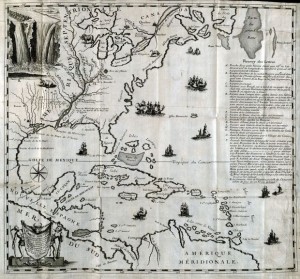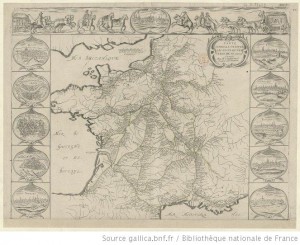by Elizabeth Goldsmith (Regular Contributor)
 Maps have always captivated the imagination as well as providing guidance for travelers. Early explorers sent home maps of their ‘discoveries’ and these were widely circulated in printed atlases and pamphlets. Even armchair travelers could imagine themselves sharing the adventures that they read about in travel accounts, a form of literature that by the eighteenth century had become more popular than novels.
Maps have always captivated the imagination as well as providing guidance for travelers. Early explorers sent home maps of their ‘discoveries’ and these were widely circulated in printed atlases and pamphlets. Even armchair travelers could imagine themselves sharing the adventures that they read about in travel accounts, a form of literature that by the eighteenth century had become more popular than novels.
By the end of the seventeenth century, even unambitious travelers could plan a road trip. With the introduction of centralized postal systems in France and England, new roads were built linking the postal stops and these roads began to be policed by government agents. For the first time travelers could ride in coaches as paying passengers, using the scheduled stops to plan their itinerary.
These improvements in infrastructure led to more road trips for people who would have been more hesitant to travel before the age of the postal routes. Anyone could move about independently and even anonymously, using a public coach. Women no longer felt obliged to disguise themselves in men’s clothes or learn to ride a horse or obtain an  escort in order to travel in safety. Almost as important as the availability of road maps for planning a trip, was the fact that these maps began to include symbols that indicating possible resting places. Finding a safe place to stay overnight could be a challenge. Early road maps indicate the location of monasteries and convents, which often functioned as hotels. The maps were decorated with images showing enticing views of cities that the traveler would pass through.
escort in order to travel in safety. Almost as important as the availability of road maps for planning a trip, was the fact that these maps began to include symbols that indicating possible resting places. Finding a safe place to stay overnight could be a challenge. Early road maps indicate the location of monasteries and convents, which often functioned as hotels. The maps were decorated with images showing enticing views of cities that the traveler would pass through.
Maps helped those who were left behind, too. Having a map meant you could follow the route of a loved one, and feel closer to them as they moved away from you or track them as they made their way home. Madame de Sévigné kept in close contact with her beloved daughter by letter following the young woman’s move from Paris to Provence with her new husband. Her mother was thrilled to obtain a road map of France after her daughter’s departure in February 1671.
 “I am still with you,” she wrote. “I see that carriage still moving, and nevermore approaching me. I am on the road and I am sometimes afraid that it will overturn; the recent rains put me in despair and the Rhone gives me a strange fear. I have a map in front of me; I know all the places where you will be staying, tonight you are in Nevers, on Sunday you will be in Lyon, where you will receive this letter.”
“I am still with you,” she wrote. “I see that carriage still moving, and nevermore approaching me. I am on the road and I am sometimes afraid that it will overturn; the recent rains put me in despair and the Rhone gives me a strange fear. I have a map in front of me; I know all the places where you will be staying, tonight you are in Nevers, on Sunday you will be in Lyon, where you will receive this letter.”
Despite the sad memory of her daughter’s departing carriage and her anxiety at being able to visualize the dangers of the route, she is relieved to be able to picture the whole voyage, and delighted by a reliable postal system.
